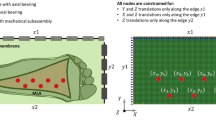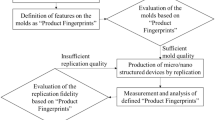Abstract
Mass production of high geometric variability surfaces, particularly in customized medical or ergonomic systems inherently display regions characterized by large variations in size, shape, and the spatial distribution. These high variability requirements result in low scalability, low production capacity, high complexity, and high maintenance and operational costs of manufacturing systems. Manufacturing molds need to physically emulate normal shapes with large variation while maintaining low complexity. A surface mold actuated with reconfigurable tooling (SMART) is proposed for molds with high variability capacity requirements for Custom Foot Orthoses (CFOs). The proposed Variability Enhanced-KBE (VEN) solution integrates a knowledge base of variations using statistical shape modeling (SSM), development of a parametric finite element (FE) model, a stepwise design optimization, and Machine Learning (ML) control. The experimentally validated FE model of the SMART system (RMSE < 0.5mm) is used for design optimization and dataset generation for the ML control algorithm. The fabricated SMART system employs discrete coarse and fine size/shape adjustment in low and high variation areas respectively. The SMART system’s experimental validation confirms an accuracy range of 0.3-0.5mm (RMSE) across the population, showing a 84% improvement over the benchmark. This VEN SMART approach may improve manufacturing in various high variability freeform surface applications.













Similar content being viewed by others
Data Availibility Statement
Not Applicable.
Abbreviations
- IFS:
-
Interfacial systems
- DMS:
-
Dedicated manufacturing system
- GMS:
-
Generalized manufacturing system
- FMS:
-
Flexible manufacturing system
- RM:
-
Reconfigurable mold
- SMART:
-
Surface mold actuated with reconfigurable tooling
- CFO:
-
Custom foot orthoses
- SSM:
-
Statistical shape modeling
- PCA:
-
Principal component analysis
- MLA:
-
Medial longitudinal arch
- KBE:
-
Knowledge-based engineering
- VEN:
-
Variability Enhanced Knowledge-based engineering
- BC:
-
Boundary condition
- RMSE:
-
Root mean square error
- RS:
-
Representative shape
- \(\mu _i\) :
-
Mean value of the scores
- M, N :
-
Coefficient matrices used for the first and second mode
- X :
-
Horizontal location of the actuators
- Y :
-
Vertical location of the actuators
- \(\sigma _i\) :
-
Standard deviation scores
- U :
-
Translations
- \(U_R\) :
-
Rotations
References
Aejmelaeus-Lindstrom, P., Willmann, J., Tibbits, S., Gramazio, F., & Kohler, M. (2016). Jammed architectural structures: Towards large-scale reversible construction. Granular Matter, 18(2), 1–12.
Akins, J. S., Karg, P. E., & Brienza, D. M. (2011). Interface shear and pressure characteristics of wheelchair seat cushions. Journal of Rehabilitation Research and Development, 48(3), 225–234.
Anderson, A. P., Newman, D. J., & Welsch, R. E. (2015). Statistical evaluation of causal factors associated with astronaut shoulder injury in space suits. Aerospace Medicine and Human Performance, 86(7), 606–613.
ArnoPronk, I.v.R., & Schinkel, P. (2009). Double-curved surfaces using a membrane mould. In Proceedings of the International Association for Shell and Spatial Structures (IASS) Symposium Valencia, Spain.
Aurelio, M., Serena, G., Monica, B., Luca, D. L., & Leonardus, V. T. M. J. (2018). An approach to design reconfigurable manufacturing tools to manage product variability: The mass customisation of eyewear. Journal of Intelligent Manufacturing, 31, 87–101.
Bousnina, K., Hamza, A., Ben Yahia, N. (2023a). An energy survey to optimize the technological parameters during the milling of AISI 304L steel using the RSM, ANN and genetic algorithm. Advances in Materials and Processing Technologies (pp. 1–19). https://doi.org/10.1080/2374068X.2023.2253658.
Bousnina, K., Hamza, A., & Yahia, N. B. (2023b). An integration of PSO-ANN and ANFIS hybrid models to predict surface quality, cost, and energy (QCE) during milling of alloy 2017A. Journal of Engineering Research. https://doi.org/10.1016/j.jer.2023.09.016
Burns, S. P., & Betz, K. L. (1999). Seating pressures with conventional and dynamic wheelchair cushions in tetraplegia. Archives of Physical Medicine and Rehabilitation, 80(5), 566–571.
Chapman, C. B., & Pinfold, M. (2001). The application of a knowledge based engineering approach to the rapid design and analysis of an automotive structure. Advances in Engineering Software, 32(12), 903–912.
Chnag-You, L. I., Kisei, I., Naoto, S., Yoshihiko, T., Takashi, M., & Shigeaki, M. (2000). Biomechanical evaluation of foot pressure and loading force during gait in rheumatoid arthritic patients with and without foot orthosis. Kurume Medicine, 47(3), 211–217.
Choi, J. W. (2009). Architecture of a knowledge based engineering system for weight and cost estimation for a composite airplane structures. Expert Systems with Applications, 36(8), 10828–10836.
ElMaraghy, H. A. (2005). Flexible and reconfigurable manufacturing systems paradigms. International Journal of Flexible Manufacturing Systems, 17(4), 261–276.
Farbiz, F., Habibullah, M. S., Hamadicharef, B., Maszczyk, T., & Aggarwal, S. (2023). Knowledge-embedded machine learning and its applications in smart manufacturing. Journal of Intelligent Manufacturing, 34(7), 2889–2906. https://doi.org/10.1007/s10845-022-01973-6
Faustini, M. C., Neptune, R. R., Crawford, R. H., & Stanhope, S. J. (2008). Manufacture of passive dynamic ankle-foot orthoses using selective laser sintering. IEEE Transactions on Biomedical Engineering, 55(2), 784–790.
Habibi, H., Land, P., Ball, M. J., Troncoso, D. A., & Branson, D. T. (2018). Optimal integration of pneumatic artificial muscles with vacuum-jammed surfaces to characterise a novel reconfigurable moulding system. Journal of Manufacturing Processes, 32, 241–253. https://doi.org/10.1016/j.jmapro.2018.02.013
Huijben, F. (2016). Vacuumatic formwork: A novel granular manufacturing technique for producing topology-optimised structures in concrete. Granular Matter. https://doi.org/10.1007/s10035-015-0602-0
Iunusova, E., Gonzalez, M. K., Szipka, K., & Archenti, A. (2023). Early fault diagnosis in rolling element bearings: Comparative analysis of a knowledge-based and a data-driven approach. Journal of Intelligent Manufacturing. https://doi.org/10.1007/s10845-023-02151-y
Jidong, W., & Mingyong, P. (2018). A depth peeling based algorithm to optimize model orientation for 3D printing. Journal of Computer-Aided Design and Computer Graphics, 30(9), 1741–1747.
Kakish, J., Zhang, P. L., & Zeid, I. (2000). Towards the design and development of a knowledge-based universal modular jigs and fixtures system. Journal of Intelligent Manufacturing, 11, 381–401.
Kelkar, A., Nagi, R., & Koc, B. (2005). Geometric algorithms for rapidly reconfigurable mold manufacturing of free-form objects. Computer-Aided Design, 37(1), 1–16.
Khan, A. S., Homri, L., Dantan, J. Y., & Siadat, A. (2022). An analysis of the theoretical and implementation aspects of process planning in a reconfigurable manufacturing system. The International Journal of Advanced Manufacturing Technology, 119, 5615–5646.
Laughton, C., McClay Davis, I., & Williams, D. S. (2002). A comparison of four methods of obtaining a negative impression of the foot. Journal of the American Podiatric Medical Association, 92(5), 261–268. https://doi.org/10.7547/87507315-92-5-261
Lung, C. W., Yang, T. D., Liau, B. Y., Cheung, W. C., Jain, S., & Jan, Y. K. (2020). Dynamic changes in seating pressure gradient in wheelchair users with spinal cord injury. Assistive Technology, 32(5), 277–286.
Mehrabi, M. G., Ulsoy, A. G., & Koren, Y. (2000). Reconfigurable manufacturing systems: Key to future manufacturing. Journal of Intelligent Manufacturing, 11(4), 403–419.
Mehrabi, M. G., Ulsoy, A. G., Koren, Y., & Heytler, P. (2002). Trends and perspectives in flexible and reconfigurable manufacturing systems. Journal of Intelligent Manufacturing, 13, 135–146.
Ou, H., Qaiser, Z., Kang, L., & Johnson, S. (2017). Experimental and computational analysis of orthotic medial longitudinal arch support height. Footwear Science, 9(sup1), S1–S2. https://doi.org/10.1080/19424280.2017.1313888
Peters, B. J. (2011). Design and fabrication of a digitally reconfigurable surface. Massachusetts Institute of Technology.
Qaiser, Z., Kunlin, Y., Rui, C., Ou, H., Faraz, A., & Johnson, S. (2022). Case study of a novel multi-actuated optimized reconfigurable freeform surface (MORFS) mold for custom foot orthoses. The International Journal of Advanced Manufacturing Technology, 120(5), 3831–3842.
Raun, C., Kristensen, M. K., & Kirkegaard, P. H., et al. (2012). Dynamic double curvature mould system. In C. Gengnagel (Ed.), Computational design modelling (pp. 291–300). Berlin: Springer.
Redmond, A. C., Landorf, K. B., & Keenan, A. M. (2009). Contoured, prefabricated foot orthoses demonstrate comparable mechanical properties to contoured, customised foot orthoses: a plantar pressure study. Journal of Foot and Ankle Research, 2, 20.
Steer, J. W., Worsley, P. R., Browne, M., & Dickinson, A. S. (2020). Predictive prosthetic socket design: Part 1-population-based evaluation of transtibial prosthetic sockets by FEA-driven surrogate modelling. Biomechanics and Modeling in Mechanobiology, 19(4), 1331–1346.
Strauss, S., Krog, R. L., & Feiveson, A. H. (2005). Extravehicular mobility unit training and astronaut injuries. Aviation Space and Environmental Medicine, 76(5), 469–474.
Sun, H., Zhao, S., Peng, F., Yan, R., Zhou, L., Zhang, T., et al. (2024). In-situ prediction of machining errors of thin-walled parts: An engineering knowledge based sparse Bayesian learning approach. Journal of Intelligent Manufacturing, 35(1), 387–411. https://doi.org/10.1007/s10845-022-02044-6
Telfer, S., Woodburn, J., Collier, A., & Cavanagh, P. R. (2017). Virtually optimized insoles for offloading the diabetic foot: A randomized crossover study. Journal of Biomechanics, 60, 157–161.
Todescato, M., Braholli, O., Chaltsev, D., Di Blasio, I., Don, D., Egger, G., et al. (2023). Sustainable manufacturing through application of reconfigurable and intelligent systems in production processes: A system perspective. Scientific Reports, 13(1), 22374. https://doi.org/10.1038/s41598-023-49727-5
Verhagen, W. J. C., Bermell-Garcia, P., van Dijk, R. E. C., & Curran, R. (2012). A critical review of Knowledge-Based Engineering: An identification of research challenges. Advanced Engineering Informatics, 26(1), 5–15.
Zhang, M., Mak, A. F. T., & Roberts, V. C. (1998). Finite element modelling of a residual lower-limb in a prosthetic socket: a survey of the development in the first decade. Medical Engineering and Physics, 20(5), 360–373.
Funding
This research is funded by the National Nature Science Foundation of China under grant numbers 52050410329 and 517500410692, and the Joint research fund for interdisciplinary research, Tongji University under grant number 2023-2-YB-16.
Author information
Authors and Affiliations
Contributions
Zeeshan Qaiser, Kunlin Yang, Shane Johnson worked on conceptualization, methodology, and preparation of the original draft with input from all authors. Both Kunlin Yang and Rui Chen developed the prototype and conducted the experiments. Dr. Shane Johnson supervised the project.
Corresponding author
Ethics declarations
Conflict of interest
The authors have no conflicts of interest to declare relevant to this article’s content.
Ethics approval
Not Applicable.
Consent to participate
Not Applicable.
Consent for publication
Not Applicable.
Code availability
Not Applicable.
Additional information
Publisher's Note
Springer Nature remains neutral with regard to jurisdictional claims in published maps and institutional affiliations.
Rights and permissions
Springer Nature or its licensor (e.g. a society or other partner) holds exclusive rights to this article under a publishing agreement with the author(s) or other rightsholder(s); author self-archiving of the accepted manuscript version of this article is solely governed by the terms of such publishing agreement and applicable law.
About this article
Cite this article
Qaiser, Z., Yang, K., Chen, R. et al. Variability-enhanced knowledge-based engineering (VEN) for reconfigurable molds. J Intell Manuf (2024). https://doi.org/10.1007/s10845-024-02361-y
Received:
Accepted:
Published:
DOI: https://doi.org/10.1007/s10845-024-02361-y




